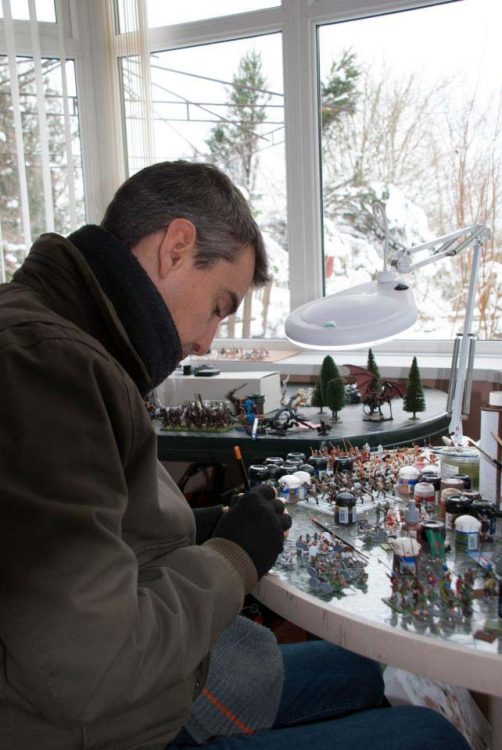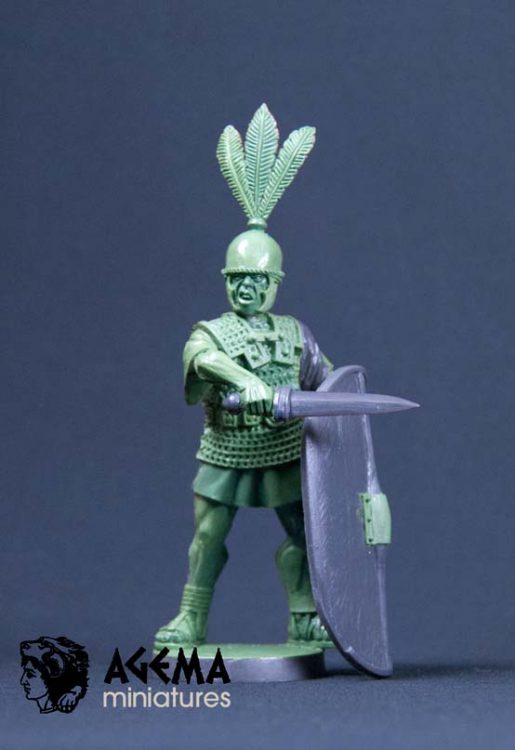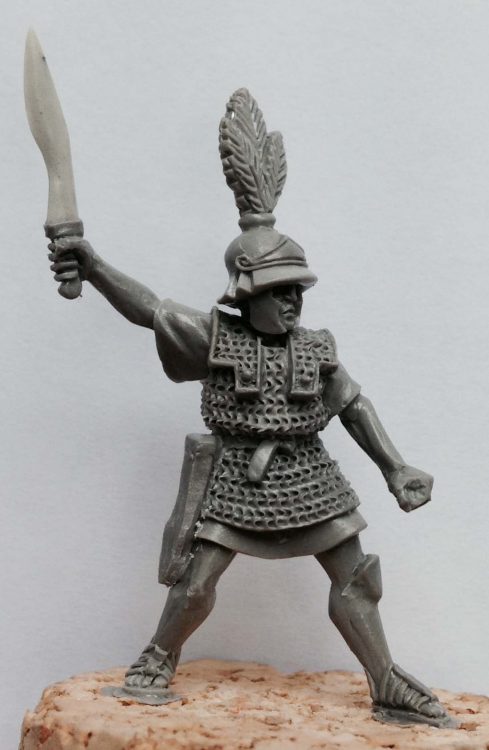Last time we asked Kawe Weissi-Zadeh of Westfalia Miniatures some questions about his company and halfmen Kickstarter. This time we put Agema Miniatures‘ Greg McBride to the question and ask him about his early wargaming career, Agema’s genesis and his plans for the company’s future.
Agema Miniatures entered the historicals market in 2013 with the first boxes of its Republican Romans range, followed by their Carthaginian opponents (see my review of the range). Since then Greg is working hard in the background to establish himself and promote Agema miniatures. But this is not how it all began…

The early years
D&B: Tell us a bit about your wargaming career. When did it all start?
Greg: Wargaming started for me at a very early age. My father was in the forces and I grew up watching him and my grandfather play Risk and other ‘War’ based games on a regular basis, both for fun and as part of their ‘day job’. As soon as I could afford to buy them, I started collecting boxes of Airfix figures; mostly ACW and Napoleonic, although WW2 featured heavily too. From there I hopped across into fantasy via Dungeons & Dragons in the early 80s, graduating to metal figures in the process. After a break while at University (playing with toy soldiers was definitely not cool down at the University bar!), I came back to Wargaming in the late 90s.
D&B: What is your personal connection to history and especially the Punic Wars?
Greg: I loved reading the books by Peter Connolly while at school – I had his books on almost permanent loan from the library! I loved the combination of accessible writing and beautiful illustrations he produced (I was saddened to hear of his passing recently).
The fact that Hannibal is often cited as being one of the greatest Generals of all time, alongside my other hero Alexander, drew me particularly to the Hellenistic and Punic Wars period. The more I read about both men, the more you have to wonder at their achievements and capabilities, and how they both won against seemingly overwhelming odds. Every boy loves a hero and Hannibal and Alexander were mine!

Agema’s foundations – doing things differently
D&B: Why did you create Agema Miniatures?
Greg: Mostly because I didn’t think the sorts of figures I wanted to collect and paint for the period were not readily available. If you can’t buy what you want, then you either go without or you have to take some direct action and make them yourself! 🙂
D&B: What is the design philosophy behind the miniatures?
Greg: I think wargamers in general can often get drawn into viewing periods of history as neatly segmented and compartmentalised, and the figures we play with can as a result end up being somewhat stereotypical; for instance, the idea that Early Imperial Roman Legionaries all wear Lorica Segmentata.
I wanted to try and make a range of figures that were as historically accurate as possible, given the evidence available, but also realistic. Ancient armour was expensive – if you could salvage and scavenge a helmet here or some armour there, then you would. So I wanted to break up the extremely homogeneous look of my figures and make them a bit more ‘lived in’; the odd anachronistic helmet, mixtures of armour etc. for instance subarmalis for the Romans.
I also wanted to make my figures more anatomically proportional – I had grown a little jaded with the massive heads and hands of many figures available and wanted something that looked more ‘proportioned’, that is as far as is possible in the mediums of plastic and metal.
Finally, I wanted to try and add some dynamism to some of our figures, such that troops would look like they were actually fighting as well as being drawn up in the more typical and static ‘ready for battle’ type array.
D&B: What is your vision for Agema Miniatures?
Greg: I’d ultimately like to cover as many troop types in as much detail as possible for the Punic Wars / late Hellenistic period (roughly 300 – 100 BC). That clearly would be an awful lot of figures and take some time to achieve, so that vision ultimately depends on whether enough of the miniature buying population out there agree with and support it!

Challenges and rewards along the way
D&B: What is or was the most challenging thing you encountered on your journey as a miniature entrepreneur?
Greg: The challenges are many. Probably the most challenging aspect is the finances – producing figures is expensive (especially in plastic) and it is a real juggling act to maintain enough sales of what you have, in order to be able to fund future releases. The buying public (me included!) wants all options and troop types available from day one in order to build the army they want as quickly as possible, but this isn’t feasible as a producer without very significant amounts of capital available to invest upfront. Also, getting the message out there and being ‘heard’ above the din of all the other manufacturers, periods and game systems out there these days is tough. Promotion is expensive and can be very hit and miss. Half of all marketing budgets are wasted, we just don’t know which half!
D&B: And in turn: What was the best experience?
Greg: The best experience is always meeting customers at shows or events, and receiving their support. It’s great to be told that someone likes and appreciates what you do sufficiently to hand over their hard earned money to you! It pleases me greatly to know that many gamers like my figures and support my vision for Agema.
What the future holds
D&B: What do you have in store for your customers in the next 12 months?
Greg: I would like to round out the Republican Romans with cavalry [those are released now] , and also expand the Carthaginian troop types we have available. Many of the African troop types that may have been available to Hannibal are not commercially available, so I’d like to cover the Carthaginians in some depth. Also, I’d like to have made a start on the Macedonians of Philip V [Phalangites in Kothybos are now available, too]
D&B: And the last one: If you could ask Hannibal Barca a question, what would it be?
Greg: Why didn’t you attack Rome when you had the chance?!!
We end with one of the most famous ‘riddles’ in ancient history. I would like to thank Greg for his time and in-depth answers to my questions. All the best with Agema Miniatures and I look forward to new releases.
I hope you found this interview interesting and informative. See you next month with another instalment!
All pictures featured in this article including the featured image are used with kind permission of Agema MIniatures under a Creative Commons Attribution-NonCommercial-NoDerivatives 4.0 International License.
I’ve just noticed a typo in my response – heterogeneous should read homogeneous. Sorry! 🙂
Hey Greg, no worries. I changed it accordingly.
I like this guy. Nice post
Glad you like the interview!